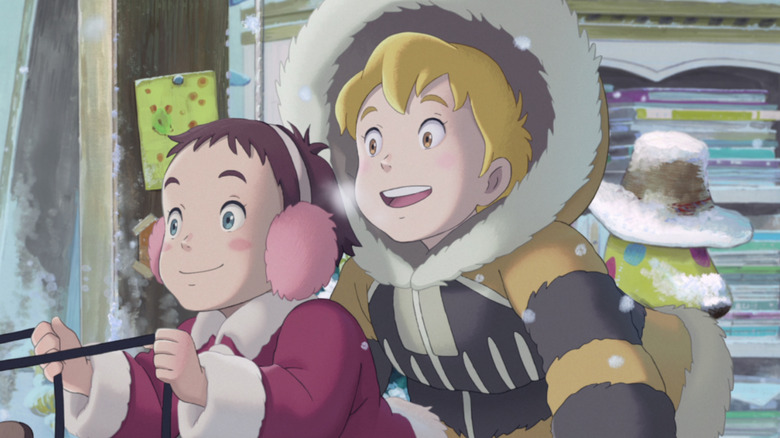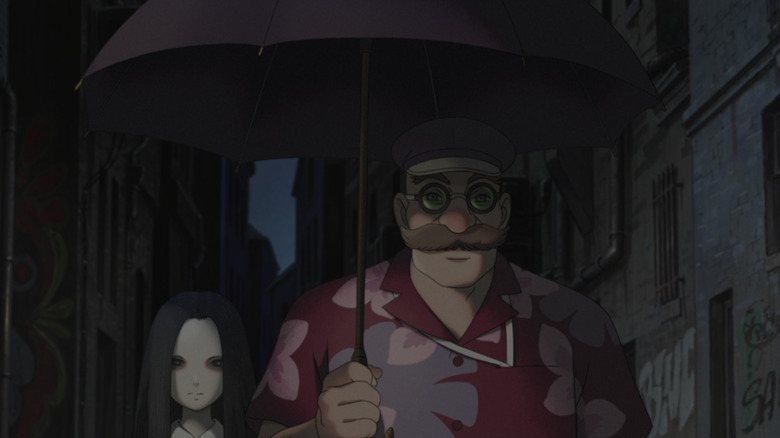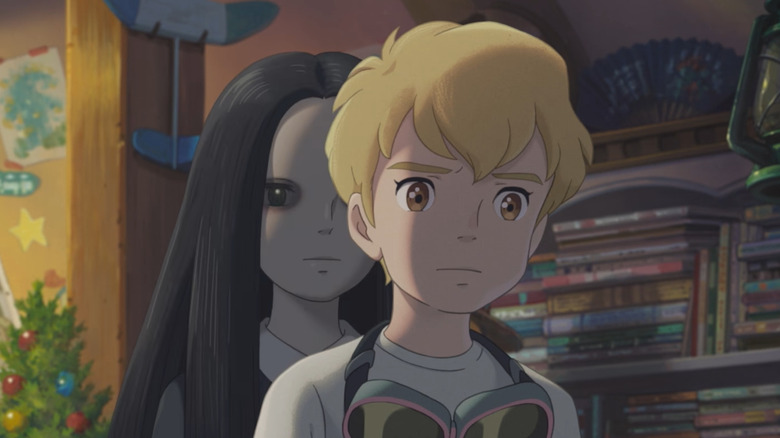How Netflix's The Imaginary Created The Best Animated Villain In A Long Time
This article contains mild spoilers for "The Imaginary."
Animation and horror is a peculiar and difficult combination. Although the West has seen kids' animated movies descend into pure horror plenty of times before, it is trickier with anime, where more often than not horror is boiled down to simply a metric ton of blood or body horror. Still, even when the atmosphere of horror doesn't work in an animated movie, chances are it will still provide a horrifying monster or villain. This has been true since the early days of feature animation in the U.S., when "Snow White" gave countless kids nightmares with the Evil Queen.
That tradition has mostly gone away, as cartoons inspired by horror are becoming increasingly rare each year. This only makes the movies that do remember the power of horror in a kid-friendly setting all the more powerful. So is the case of "The Imaginary," the new movie from Studio Ponoc which our own BJ Colangelo described as "a breathtaking feat of animation with a powerful story that lends it to being a generational classic in the making" in her review.
In the film, an imaginary friend named Rudger is chased by a monster, who looks like a creepy old guy in a Hawaiian shirt named Mr. Bunting. Under the surface, however, he is one of the scariest monsters in recent all-ages movie memory. As writer and producer Yoshiaki Nishimura told /Film at the Annecy Animation Film Festival, there were plans for a lot more Mr. Bunting than we see in the film. "There is a saga of the backstory," Nishimura said via a translator. "We don't have enough time to go into the details [in the movie], unfortunately, it just would take too long."
A terrifying villain
In the world of "The Imaginary," Mr. Bunting is something of a boogeyman for imaginary friends, a myth about a monster that literally eats imaginary friends because he doesn't have an imagination of his own anymore. He's kind of a cross between the titular heron from Miyazaki's "The Boy and The Heron" and King's Pennywise the Clown from "It," meaning once he gets close, he reveals a second form that's much scarier and menacing. When Mr. Bunting goes for the attack and tries to kill Rudger, he opens his mouth wider than any living being should be able to do, his gullet expanding to infinity while the screams of imaginary friends can be heard deep inside him.
Though he works perfectly as a villain with the vaguest of backstories, it is fascinating to see how much thought Nishimura added to Bunting's backstory independently from the original novel by A. F. Harrold and illustrated by Emily Gravett, especially since it ultimately went unseen. "He's somebody who has lived for a long time, around 300 years or so, and I think he represents those who have experienced great loss over a period of time," the writer said.
According to Nishimura, Bunting was "robbed of something that he really valued by his parents" and that's part of why he became who he is in the film. He is the worst-case scenario for a kid with imagination, and he represents what would happen if Amanda never loses Rudger going forward, if she clings onto his imaginary friend and doesn't let go. Indeed, in the film, we learn that Bunting wants to continue seeing his own imaginary friend, and to do so he will consume other imaginary friends, much like Pennywise hunting kids.
The J-horror ghostly companion
If Mr. Bunting wasn't scary enough as it is, he is always accompanied by his own imaginary friend, a girl who "smells like rot and is cold as an icicle," who happens to look just like Sadako from "Ringu." The character design is based on the original book illustration, which Nishimura admits "did look a lot like Japanese horror characters like Sadako," with director Yoshiyuki Momose initially drawing the girl with "more of a sense of harshness, really quite cold, scary look to her." Indeed, if Bunting is the Dark Lord who comes for the kill at the last second, then his imaginary friend is a Nazgûl who chases after his prey for him and gets them ready to be devoured. It doesn't help that she can shapeshift and turn into giant monsters and flying terrors.
Speaking about adding horror elements to "The Imaginary," Nishimura said that "there is also a necessity to really understand that this is the world and I didn't really want to mollycoddle children in order for them to be protected, for them to be in this bubble of not really face up to the scariness." This is the key to "The Imaginary," a film that is all about the power of imagination and wonder, but one that doesn't shy away from showing that, often, imagination is a coping mechanism to escape from the horrors of reality. And, really, when Mr. Bunting and his Sadako henchgirl are part of your reality, do everything you can to run the hell away.


